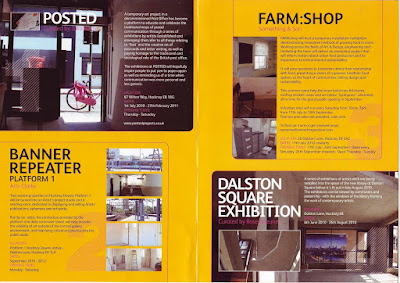




Below is an image of a less than recent package, one of 16, which when all together formed a complete circle. The packages were posted around the world - including one to Field Study. When, ‘Theatre of Names and Addresses’ met ‘Field Study’
A sturdy man of heat dressed flies and steed.
Field Study’s mane17 not only has the sometimes onerous task of communing with the abundance of dead/un-dead canonry but also the task of ‘engaging’ with living cultures here, locally and further afield. This involves the risk of getting caught in the cross fire and mayhem of iconoclastic discourse. Recently I witnessed a Mr D Mabb sticking a florally decorated wellington boot into a slide show at the William Morris Gallery; this was not a pretty sight even if the boot hailed from the venerable Victoria and Albert Museum gift shop.
I have done some research into public art in Walthamstow and the London Borough of Waltham Forest as a whole, asking how easy (or otherwise) it is getting access to its public art works e.g. ‘Linked’ by Graham Miller. I have asked what sort of curatorial care and knowledge there is of and for the public art works around the borough e.g. the sculptures on the exterior wall of the core of a heart of darkness; the council chamber in the prestigious listed Walthamstow Town Hall. This research has resulted in some artist talks and walks for the E17 Art Trail.
Could Walthamstow ever be a public art free zone?
It is worth keeping a close eye on how neighbouring boroughs are supporting public art particularly at this time when, nationwide, local authority expenditure is subject to ‘swingeing cuts’.
Below are scans of each side of a recently found leaflet promoting projects and exhibitions in Hackney.
Go to www.artinemptyspaces.org.uk for more information.
POSTED and FARM:SHOP are particularly interesting to me and I hope to visit them in the New Year.
Go to www.postedprojects.co.uk for more information.




Photo: Susan Hartigan.
Above are two images from a mail art documentation produced by David Dellafiora for a Field Study emanation, Splendid Lights. Top is the project invitation, bottom an image from the Splendid Lights event. If the invitation/project brief (top) isn’t readable, participants were invited to decorate or treat domestic light bulbs and send them to David who displayed them ‘off’ and illuminated at ‘Madame Lillies’ - which, I think, might have been an empty or partially empty shop on Stoke Newington Church Street in Hackney, London.
At the time I worked in a resource centre for physically disabled adults. I encouraged some of the centre users to decorate and contribute bulbs. Each contributor received a documentation in which their contribution was credited. There was a lot of enthusiasm for more participation in art projects - public and otherwise.
The resource centre was run by Hertfordshire Social Services. At that time there was concern about exclusion - that day centres did not include all the service users whose religious, ethnic and racial identities did not match those of a dominant culture. The involvement of folk in Splendid Lights was seen as positive implementation of a policy of multiculturalism. I still have doubts about this interpretation.
One of my doubts concerns how social therapeutic processes with many dimensions, facets and restrictions can be reduced to institutional totems. In so doing they may represent processes or products which are the very opposite (of outcomes) of policies aiming to achieve inclusion for marginalised minorities.
Below is a photogram of the light bulb I contributed to Splendid Lights. I smashed a dead bulb and painted the glass fragments black. I stuck the fragments to a live bulb using super glue. The bonds held however they were fragile and I tried a number of other glues and resins; each with concerns about fumes and other reactions between the hot bulb and glues.
There were several narratives including jokes e.g. about fragile objects breaking in the post. I liked the idea of a moment of illumination breaking the darkness - and of associated word games particularly involving idioms - the shedding of light, skin, and darkness. It was a sort of reduced version of Cornelia Parker’s, ‘Cold Dark Matter’ in which the artist blew up a shed, suspended all the debris in a gallery space at the centre of which hung a single light bulb casting an array of shadows.

Lightbulb. Photogram - David Dellafiora. Bulb - Julian Beere.
Your mane17 is sniffing around in the darkness of his limited imagination searching for an idea; a path to follow to the heart of nowhere near ......
15th February 2023, from E4:
On 'dream' and 'dweam', it seems to me that you have made an error - for surely, the acronym for 'dead white artistic male' is 'dwam', not 'dweam'. I think, therefore, that you may have omitted an e word or, an E word. Perhaps you meant to omit the e word, or the E word. If you were to insert an E (word) into 'dwam' to make 'dwEam' - you could make 'dwEam' an acronym for, 'dead white European artistic male'. It seems to me that you are still sniffing around in the darkness of your limited imagination that is also the darkness of the dwEams, that might also be broken via the use of reduced interpretations of the dreams of more illuminated others.

